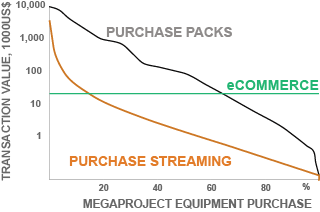
B2B - business-to-business - is a process of selling products or services to other businesses. Both in the U.S. and worldwide, the B2B eCommerce market is more than twice the size of the B2C market.
According to Forrester's forecast US B2B e-Commerce volume will exceed $2 trillion in 2023 and $3 trillion by 2027 (24% of total US B2B sales). At the same time, B2B buyers are growing increasingly impatient with B2B sellers that do not provide B2C-like customer experiences online.
B2B lagging behind B2C lies in their principal difference.
B2C is driven by a consumer's desire to immediately possess some commodities or services. B2C transaction is emotionally triggered by a B2C ad campaign and goes in synch.
B2B is driven by corporate reason to make some plant or device work and produce other commodities and services. B2B buyers are only a link in a chain of decisions leading to the B2B transaction. The latter and the B2B ad campaign are never in synch: the B2B marketers "push" product-advertising materials to the prospects and try to engage them long before the actual B2B transaction takes place. Unlike B2C, B2B may go off/online many times.
In other words, those who will find a way to control the decision-making chain, will eventually monopolize the B2B eCommerce (eProcurement) and take up its biggest part - 88% or US$7.3 trillion.
Over 80% of this figure is in the manufacturing, maintenance, and operation sectors. The share of process capital projects (oil and gas, chemical, pharma and water) in B2B commerce is rather small. In my opinion, it may recover to 8% by 2025.
Regardless of the industry, the decision-making chain is basically the same. I will illustrate its working in the water treatment and desalination mega-projects - the major source of my experience.
The current practice adopted by many EPC contractors is to bundle purchase items of similar design into bigger order packages to save on the paperwork and the bureaucracy of approvals. How big is the purchase package depends on the manufacturing products range of pre-selected manufacturers. For example, not all pump manufacturers work with super-duplex steels resistant to corrosion in seawater. Therefore, those who work may get purchase orders with more items.
If the package price is above some pre-defined value, it should be approved by a purchasing committee – the heaviest chain in decision-making. Each adds 2 - 6 weeks to the project schedule.
As follows from the graph above showing the distribution of the purchase package prices for the US$160 million desalination plant, if the transaction value limit is set to US$20,000, only 35% of all purchasing orders may be processed without approval of the purchasing committee.
It leads us to rather a pessimistic conclusion that within the frame of current procurement practice B2B eCommerce (or eProcurement) has no chance to penetrate the capital projects market.
On the contrary, not bundling items into purchase packages - procurement streaming - raises the percentage of orders eligible for e-Procurement to 85%!
Procurement streaming increases the paperwork volume by a factor of 10 as each order shall be accompanied by the purchase terms tailored to the product and the manufacturer status. This formal work is ideal for automation.
The current handshake scheme between the EPC contractor and the original equipment manufacturer (OEM), describing the B2B procurement, is a 6-step procedure.
| Step | Content | Crenger |
|---|---|---|
| 1 | The consumer pre-qualifies OEM according to survey results and register it on the product and service categories |  |
| 2 | The consumer notifies OEM on RFQ/Public/Private tenders |  |
| 3 | OEM submits quotation |  |
| 4 | The consumer compares technical and commercial offers and selects the winning one |  |
| 5 | The consumer adds the product to the project schedule and orders the product |  |
| 6 | The consumer tracks the order execution |  |
In the table, 5 out of 6 tasks belong to the consumer. It means that B2B eProcurement works opposite to B2C; the consumer builds eProcurement platform for OEMs to participate.

